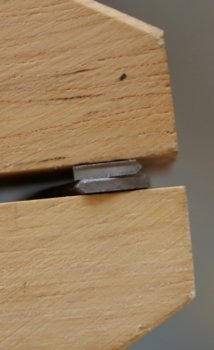Kurt Krueger
Well-Known Member
Below is a picture of a cross section from a blade I just heat treated. It's 1/16" 1095. Here's the process I followed:
Normalize for 10 minutes each at 1575, 1475, 1400, air cooling to black between each.
Austenized to 1475 and quenched in park's 50
Spheoridized at 1300 and allowed to cool in oven until it reached 135F (took ~ 6 hours to cool)
Austenized at 1475 for 15 minutes and quenched in park's 50.
My question is whether there is anything I can tell from the appearance of the fracture. The picture isn't perfect, but the break appears like a silver gray with no shiny crystal-like spots. In general, it looks like a broken file. I hope that's a good sign.
I can't say what the hardness is, I have access to a hardness tester, but can't get to it until tomorrow. In the mean time, I'm tempering the blades for two 2-hour tempers at 375. In theory, that should bring an ideally heat treated blade down to about 63.
Can anyone comment on the appearance in the photo?
Thanks
-Kurt

Normalize for 10 minutes each at 1575, 1475, 1400, air cooling to black between each.
Austenized to 1475 and quenched in park's 50
Spheoridized at 1300 and allowed to cool in oven until it reached 135F (took ~ 6 hours to cool)
Austenized at 1475 for 15 minutes and quenched in park's 50.
My question is whether there is anything I can tell from the appearance of the fracture. The picture isn't perfect, but the break appears like a silver gray with no shiny crystal-like spots. In general, it looks like a broken file. I hope that's a good sign.
I can't say what the hardness is, I have access to a hardness tester, but can't get to it until tomorrow. In the mean time, I'm tempering the blades for two 2-hour tempers at 375. In theory, that should bring an ideally heat treated blade down to about 63.
Can anyone comment on the appearance in the photo?
Thanks
-Kurt

